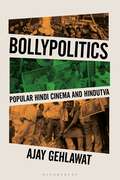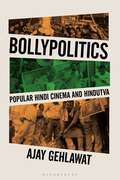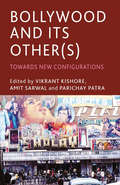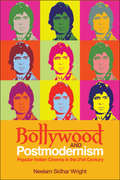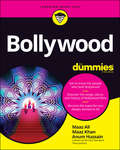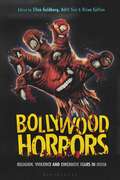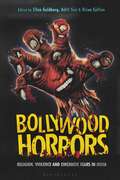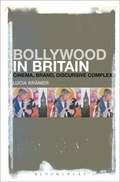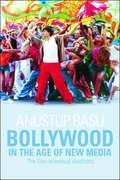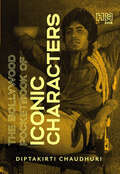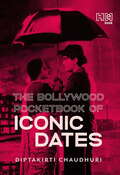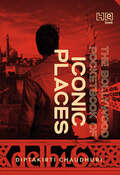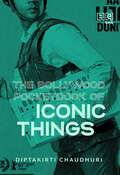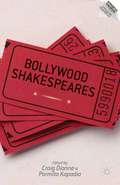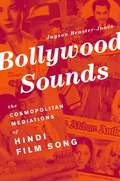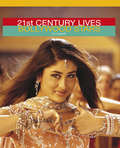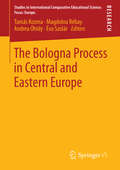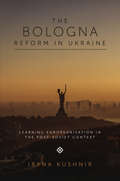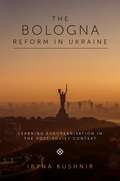- Table View
- List View
Bollypolitics: Popular Hindi Cinema and Hindutva (World Cinema)
by Ajay GehlawatThis book provides an in-depth exploration of the evolving landscape of Bollywood cinema in response to recent socio-political changes in India, including a surge in sectarian violence and the ascent of Hindutva, or Hindu nationalism, under Prime Minister Narendra Modi's leadership. Through a comprehensive analysis of prominent filmmakers and actors like Sanjay Leela Bhansali, Kangana Ranaut, Akshay Kumar, and Anupam Kher, Ajay Gehlawat investigates the extent to which their recent works align with key tenets of the Hindutva movement. He scrutinizes the growing influence of the Bharatiya Janata Party (BJP) on film production, manifesting in collaborations covering diverse themes, from Modi's Clean India initiative to the nation's space exploration endeavors and grand historical epics such as Padmaavat (2018) and Manikarnika (2019) that seek to reshape Indian history in line with Hindutva ideology.Gehlawat goes on to dissect smaller budget films like Article 15 (2019) and Shubh Mangal Zyada Saavdhan (2020), which tackle pressing social issues like caste-based violence and homophobia exacerbated by the surge in right-wing extremism in India. In doing so, he elucidates the profound and far-reaching impact of Hindutva ideology on Indian cinematic narratives and aesthetics, while also considering the broader implications for Indian society as a whole.
Bollypolitics: Popular Hindi Cinema and Hindutva (World Cinema)
by Ajay GehlawatThis book provides an in-depth exploration of the evolving landscape of Bollywood cinema in response to recent socio-political changes in India, including a surge in sectarian violence and the ascent of Hindutva, or Hindu nationalism, under Prime Minister Narendra Modi's leadership. Through a comprehensive analysis of prominent filmmakers and actors like Sanjay Leela Bhansali, Kangana Ranaut, Akshay Kumar, and Anupam Kher, Ajay Gehlawat investigates the extent to which their recent works align with key tenets of the Hindutva movement. He scrutinizes the growing influence of the Bharatiya Janata Party (BJP) on film production, manifesting in collaborations covering diverse themes, from Modi's Clean India initiative to the nation's space exploration endeavors and grand historical epics such as Padmaavat (2018) and Manikarnika (2019) that seek to reshape Indian history in line with Hindutva ideology.Gehlawat goes on to dissect smaller budget films like Article 15 (2019) and Shubh Mangal Zyada Saavdhan (2020), which tackle pressing social issues like caste-based violence and homophobia exacerbated by the surge in right-wing extremism in India. In doing so, he elucidates the profound and far-reaching impact of Hindutva ideology on Indian cinematic narratives and aesthetics, while also considering the broader implications for Indian society as a whole.
Bollywood and its Other(s): Towards New Configurations
by Vikrant Kishore Amit Sarwal Parichay PatraHow do we define the globalized cinema and media cultures of Bollywood in an age when it has become part of the cultural diplomacy of an emerging superpower? Bollywood and Its Other(s) explores the aesthetic-philosophical questions of the other through, for example, discussions on Indian diaspora's negotiations with national identity.
Bollywood and Postmodernism: Popular Indian Cinema in the 21st Century
by Neelam Sidhar Wright‘New Bollywood’ has arrived, but its postmodern impulse often leaves film scholars reluctant to theorise its aesthetics. How do we define the style of a contemporary Bollywood film? Are Bollywood films just uninspired Hollywood rip-offs, or does their borrowing signal genuine innovation within the industry? Applying postmodern concepts and locating postmodern motifs in key commercial Hindi films, this innovative study reveals how Indian cinema has changed in the 21st century. Equipping readers with an alternative method of reading contemporary Indian cinema, Bollywood and Postmodernism takes Indian film studies beyond the exhausted theme of diaspora, and exposes a new decade of aesthetic experimentation and textual appropriation in mainstream Bombay cinema. A bold celebration of contemporary Bollywood texts, this book radically redefines Indian film and persuasively argues for its seriousness as a field of study in world cinema.
Bollywood and Postmodernism: Popular Indian Cinema in the 21st Century
by Neelam Sidhar Wright‘New Bollywood’ has arrived, but its postmodern impulse often leaves film scholars reluctant to theorise its aesthetics. How do we define the style of a contemporary Bollywood film? Are Bollywood films just uninspired Hollywood rip-offs, or does their borrowing signal genuine innovation within the industry? Applying postmodern concepts and locating postmodern motifs in key commercial Hindi films, this innovative study reveals how Indian cinema has changed in the 21st century. Equipping readers with an alternative method of reading contemporary Indian cinema, Bollywood and Postmodernism takes Indian film studies beyond the exhausted theme of diaspora, and exposes a new decade of aesthetic experimentation and textual appropriation in mainstream Bombay cinema. A bold celebration of contemporary Bollywood texts, this book radically redefines Indian film and persuasively argues for its seriousness as a field of study in world cinema.
Bollywood Cinema: Temples of Desire
by Vijay MishraIndia is home to Bollywood - the largest film industry in the world. Movie theaters are said to be the "temples of modern India," with Bombay producing nearly 800 films per year that are viewed by roughly 11 million people per day. In Bollywood Cinema, Vijay Mishra argues that Indian film production and reception is shaped by the desire for national community and a pan-Indian popular culture. Seeking to understand Bollywood according to its own narrative and aesthetic principles and in relation to a global film industry, he views Indian cinema through the dual methodologies of postcolonial studies and film theory. Mishra discusses classics such as Mother India (1957) and Devdas (1935) and recent films including Ram Lakhan (1989) and Khalnayak (1993), linking their form and content to broader issues of national identity, epic tradition, popular culture, history, and the implications of diaspora.
Bollywood Cinema: Temples of Desire
by Vijay MishraIndia is home to Bollywood - the largest film industry in the world. Movie theaters are said to be the "temples of modern India," with Bombay producing nearly 800 films per year that are viewed by roughly 11 million people per day. In Bollywood Cinema, Vijay Mishra argues that Indian film production and reception is shaped by the desire for national community and a pan-Indian popular culture. Seeking to understand Bollywood according to its own narrative and aesthetic principles and in relation to a global film industry, he views Indian cinema through the dual methodologies of postcolonial studies and film theory. Mishra discusses classics such as Mother India (1957) and Devdas (1935) and recent films including Ram Lakhan (1989) and Khalnayak (1993), linking their form and content to broader issues of national identity, epic tradition, popular culture, history, and the implications of diaspora.
Bollywood For Dummies
by Maaz Ali Maaz Khan Anum HussainTake the trip of a lifetime into the past and present of Bollywood Fascinated by the high energy, high emotion, high color, endless dance routines, and sheer scale of Bollywood—but afraid you'll never really know your Ghazals from your Qawwalis, or your Khans from your Kapoors? Well, in the immortal line from the Hindi-language blockbuster Sultan, "No one can defeat you unless you accept defeat yourself," and there's no need to be defeated at all when you can sit back with Bollywood For Dummies and immerse yourself in the glamorous whirl of one of the most exciting movie industries on Earth. Starting with the time-travel adventure of the book’s main feature—the history of the Hindi-speaking industry from people and events of early to mid 20th century Mumbai—you'll also journey in space, taking fascinating documentary side trips to get to know Tollywood’s Telegu-language cinema in southern India, as well as the growing influence of Lollywood across the border in Pakistan. Written by the cohosts of Desi Standard Time, a podcast that explores Bollywood and South Asian movies and media, you'll see how the unique cinema culture of Bollywood in particular has become a global phenomenon, reflecting the rise of India as an independent nation and presenting its long history—and it’s exciting and multifaceted present—in new, influential, and enduring forms. Whatever you paid the price of entry for: the popular Bollywood "Masala" movie style that emphasizes music, comedy, romance, and action; sensitive critiques of a fast-changing society by the Indian Social Realism movement; new forms of music from Indian disco to Sufi boogie; or a look at the lives and talents of the great acting dynasties—it's all here. And there'll still be plenty more plot twists beyond these to surprise and delight you. Get to know the people who built Bollywood Discover the main music and dance styles Explore and recognize Bollywood’s influence on Western cinema Go social and join up with the liveliest Bollywood fan communities You're right to be excited: for newbies a whole new world awaits, and for aficionados, there's always so much more to know. So, sit back with this book, grab some popcorn or a plate of samosas—or why not both—and prepare to begin an electric feast to sizzle all your senses.
Bollywood For Dummies
by Maaz Ali Maaz Khan Anum HussainTake the trip of a lifetime into the past and present of Bollywood Fascinated by the high energy, high emotion, high color, endless dance routines, and sheer scale of Bollywood—but afraid you'll never really know your Ghazals from your Qawwalis, or your Khans from your Kapoors? Well, in the immortal line from the Hindi-language blockbuster Sultan, "No one can defeat you unless you accept defeat yourself," and there's no need to be defeated at all when you can sit back with Bollywood For Dummies and immerse yourself in the glamorous whirl of one of the most exciting movie industries on Earth. Starting with the time-travel adventure of the book’s main feature—the history of the Hindi-speaking industry from people and events of early to mid 20th century Mumbai—you'll also journey in space, taking fascinating documentary side trips to get to know Tollywood’s Telegu-language cinema in southern India, as well as the growing influence of Lollywood across the border in Pakistan. Written by the cohosts of Desi Standard Time, a podcast that explores Bollywood and South Asian movies and media, you'll see how the unique cinema culture of Bollywood in particular has become a global phenomenon, reflecting the rise of India as an independent nation and presenting its long history—and it’s exciting and multifaceted present—in new, influential, and enduring forms. Whatever you paid the price of entry for: the popular Bollywood "Masala" movie style that emphasizes music, comedy, romance, and action; sensitive critiques of a fast-changing society by the Indian Social Realism movement; new forms of music from Indian disco to Sufi boogie; or a look at the lives and talents of the great acting dynasties—it's all here. And there'll still be plenty more plot twists beyond these to surprise and delight you. Get to know the people who built Bollywood Discover the main music and dance styles Explore and recognize Bollywood’s influence on Western cinema Go social and join up with the liveliest Bollywood fan communities You're right to be excited: for newbies a whole new world awaits, and for aficionados, there's always so much more to know. So, sit back with this book, grab some popcorn or a plate of samosas—or why not both—and prepare to begin an electric feast to sizzle all your senses.
Bollywood Horrors: Religion, Violence and Cinematic Fears in India
by Ellen Goldberg, Aditi Sen, and Brian CollinsBollywood Horrors is a wide-ranging collection that examines the religious aspects of horror imagery, representations of real-life horror in the movies, and the ways in which Hindi films have projected cinematic fears onto the screen. Part one, “Material Cultures and Prehistories of Horror in South Asia” looks at horror movie posters and song booklets and the surprising role of religion in the importation of Gothic tropes into Indian films, told through the little-known story of Sir Devendra Prasad Varma. Part two, “Cinematic Horror, Iconography and Aesthetics” examines the stereotype of the tantric magician found in Indian literature beginning in the medieval period, cinematic representations of the myth of the fearsome goddess Durga's slaying of the Buffalo Demon, and the influence of epic mythology and Hollywood thrillers on the 2002 film Raaz. The final part, “Cultural Horror,” analyzes elements of horror in Indian cinema's depiction of human trafficking, shifting gender roles, the rape-revenge cycle, and communal violence.
Bollywood Horrors: Religion, Violence and Cinematic Fears in India
Bollywood Horrors is a wide-ranging collection that examines the religious aspects of horror imagery, representations of real-life horror in the movies, and the ways in which Hindi films have projected cinematic fears onto the screen. Part one, “Material Cultures and Prehistories of Horror in South Asia” looks at horror movie posters and song booklets and the surprising role of religion in the importation of Gothic tropes into Indian films, told through the little-known story of Sir Devendra Prasad Varma. Part two, “Cinematic Horror, Iconography and Aesthetics” examines the stereotype of the tantric magician found in Indian literature beginning in the medieval period, cinematic representations of the myth of the fearsome goddess Durga's slaying of the Buffalo Demon, and the influence of epic mythology and Hollywood thrillers on the 2002 film Raaz. The final part, “Cultural Horror,” analyzes elements of horror in Indian cinema's depiction of human trafficking, shifting gender roles, the rape-revenge cycle, and communal violence.
Bollywood in Britain: Cinema, Brand, Discursive Complex
by Lucia KrämerBollywood in Britain provides the most extensive survey to date of the various manifestations and facets of the Bollywood phenomenon in Britain. The book analyzes the role of Hindi films in the British film market, it shows how audiences engage with Bollywood cinema and it discusses the ways the image of Bollywood in Britain has been shaped. In contrast to most of the existing books on the subject, which tend to approach Bollywood as something that is made by Asians for Asians, the book also focuses on how Bollywood has been adapted for non-Asian Britons. An analysis of Bollywood as an unofficial brand is combined with in-depth readings of texts like film reviews, the TV show Bollywood Star (2004) and novels and plays with references to the Bombay film industry. On this basis Bollywood in Britain demonstrates that the presentation of Bollywood for British mainstream culture oscillates between moments of approximation and distancing, with a clear dominance of the latter. Despite its alleged transculturality, Bollywood in Britain thus emerges as a phenomenon of difference, distance and Othering.
Bollywood in Britain: Cinema, Brand, Discursive Complex
by Lucia KrämerBollywood in Britain provides the most extensive survey to date of the various manifestations and facets of the Bollywood phenomenon in Britain. The book analyzes the role of Hindi films in the British film market, it shows how audiences engage with Bollywood cinema and it discusses the ways the image of Bollywood in Britain has been shaped. In contrast to most of the existing books on the subject, which tend to approach Bollywood as something that is made by Asians for Asians, the book also focuses on how Bollywood has been adapted for non-Asian Britons. An analysis of Bollywood as an unofficial brand is combined with in-depth readings of texts like film reviews, the TV show Bollywood Star (2004) and novels and plays with references to the Bombay film industry. On this basis Bollywood in Britain demonstrates that the presentation of Bollywood for British mainstream culture oscillates between moments of approximation and distancing, with a clear dominance of the latter. Despite its alleged transculturality, Bollywood in Britain thus emerges as a phenomenon of difference, distance and Othering.
Bollywood in the Age of New Media: The Geo-televisual Aesthetic (Edinburgh University Press)
by Anustup BasuThis is a study of popular Indian cinema in the age of globalisation, new media, and metropolitan Hindu fundamentalism, focusing on the period between 1991 and 2004.
The Bollywood Pocketbook of Iconic Characters
by Diptakirti ChaudhuriA goddess who defeated the box-office gods. An emperor who was defeated by a slave girl.A child who became an adult too soon. An adult who went the other way.An alcoholic. A teetotaller. A millionaire. A tramp.The Bollywood Pocketbook of Iconic Characters showcases 50 legendary characters that have become icons of Hindi cinema. Characters we have wanted to become. Characters we have loved, hated, lusted after, and even worshipped. Characters with whom we have laughed, for whom we have cried, and whose lives became inspirations for the stories of our own lives.Whether you're a trivia buff or a die hard Bollywood fan, or on your way to converting detractors into becoming one, this must-have book will have you declaring 'Unka naam toh suna hoga!'
The Bollywood Pocketbook of Iconic Dates
by Diptakirti ChaudhuriA Hindi film goes to Cannes. Raj Kapoor goes to Russia.Dilip Kumar stands up in court against Madhubala. Stardust finds itself facing a judge...again!Amitabh Bachchan resurrects himself. Gulshan Kumar is shot dead.The Bollywood Pocketbook of Iconic Dates records 50 momentous dates that mark major breakthroughs in the history of Hindi cinema. Dates on which blockbusters released and started trends. Dates when the country's politics was influenced by a film. And dates on which Hindi cinema changed the world as we knew it!Whether you're a trivia buff or a die hard Bollywood fan, or on your way to converting detractors into becoming one, this must-have book will have you proclaiming 'Tareekh par tareekh, tareekh par tareekh!'
The Bollywood Pocketbook of Iconic Places
by Diptakirti ChaudhuriA studio that became a school. A city that made Bihar cool.A mansion. A single-screen theatre.An icy mountain, a theatre of war. A distant island, a mega-villain's lair.The Bollywood Pocketbook of Iconic Places drops the pin on 50 memorable places that mark milestones in Hindi cinema. Places that started off as shooting locations but became landmarks. Fictional places that have become an indelible part of our childhoods. And a place inspired by a radio frequency!Whether you're a trivia buff or a die hard Bollywood fan, or on your way to converting detractors into becoming one, this must-have book will have you singing 'Yeh kahaan aa gaye hum!'
The Bollywood Pocketbook of Iconic Things
by Diptakirti ChaudhuriA gramophone record that didn't carry a name. A train that went up in flames.Shoes that identified a villain. Shoes that identified a hero.A cap that everyone wanted. A bag of diamonds that no one got.The Bollywood Pocketbook of Iconic Things lists 50 iconic items that have become symbolic of the Hindi film industry. Things that changed the definition of romance. Things that united the nation. Things that define a generation. These are things that have transcended from the movie screens to our lives, things that have kept us awake for many moonlit nights.Whether you're a trivia buff or a die hard Bollywood fan, or on your way to converting detractors into becoming one, this must-have book will have you humming 'Mera kuchh saamaan...!'
Bollywood Shakespeares (Reproducing Shakespeare)
by Craig Dionne Parmita KapadiaHere, essays use the latest theories in postcolonialism, globalization, and post-nationalism to explore how world cinema and theater respond to Bollywood's representation of Shakespeare. In this collection, Shakespeare is both part of an elite Western tradition and a window into a vibrant post-national identity founded by a global consumer culture.
Bollywood Sounds: The Cosmopolitan Mediations of Hindi Film Song
by Jayson Beaster-JonesBollywood Sounds focuses on the songs of Indian films in their historical, social, commercial, and cinematic contexts. Author Jayson Beaster-Jones takes readers through the highly collaborative compositional process, highlighting the contributions of film directors, music directors (composers), lyricists, musicians, and singers in song production. Through close musical and multimedia analysis of more than twenty landmark compositions, Bollywood Sounds illustrates how the producers of Indian film songs have long mediated a variety of musical styles, instruments, and performance practices to create a uniquely cosmopolitan music genre. As an exploration of the music of seventy years of Hindi films, Bollywood Sounds provides long-term historical insights into film songs and their musical and cinematic conventions in ways that will appeal both to scholars and to newcomers to Indian cinema.
Bollywood Sounds: The Cosmopolitan Mediations of Hindi Film Song
by Jayson Beaster-JonesBollywood Sounds focuses on the songs of Indian films in their historical, social, commercial, and cinematic contexts. Author Jayson Beaster-Jones takes readers through the highly collaborative compositional process, highlighting the contributions of film directors, music directors (composers), lyricists, musicians, and singers in song production. Through close musical and multimedia analysis of more than twenty landmark compositions, Bollywood Sounds illustrates how the producers of Indian film songs have long mediated a variety of musical styles, instruments, and performance practices to create a uniquely cosmopolitan music genre. As an exploration of the music of seventy years of Hindi films, Bollywood Sounds provides long-term historical insights into film songs and their musical and cinematic conventions in ways that will appeal both to scholars and to newcomers to Indian cinema.
Bollywood Stars: Bollywood Stars Library Ebook (21st Century Lives #19)
by Liz Gogerly21st Century Lives is a fresh and lively approach to the achievements of the most popular Bollywood stars.
The Bologna Process in Central and Eastern Europe (Studien zur international vergleichenden Erziehungswissenschaft. Schwerpunkt Europa - Studies in International Comparative Educational Science. Focus: Europe.)
by Tamas Kozma Andrea Ohidy Magdolna Rébay Éva SzolárThe Bologna Process opened a new chapter in the history of the European higher education. The idea of a common European Higher Education Area was developed in Western Europe and accelerated increasingly there in the second half of the 20th century, as a phenomenon of globalization. For the post-communist states in Eastern Europe the complete change of the political system made it possible to join the European Union and the Bologna Process. These changes had an impact not only on the educational policies but also on the educational system and the educational culture as well. This book shows the changes in the higher education of ten countries in Central and Eastern Europe. The country studies are supplemented with an international and a historical comparative analysis, to point out the special features of the implementation of the Bologna aims in the region.
The Bologna Reform in Ukraine: Learning Europeanisation in the Post-Soviet Context
by Iryna KushnirThe Bologna Process is one of the most well-known and influential European projects for cooperation in the field of higher education. Through an in-depth examination of higher education actors and policy instruments in the case of the implementation of Bologna in Ukraine, this book aims to analyse the process of the Bologna reform in Ukraine and investigate Bologna as a case of Europeanisation in the post-Soviet context. Collating findings that suggest that the Bologna reform in Ukraine has been developing primarily as an interrelationship between policy continuity and change, the author demonstrates how the old practices and new innovations in Bologna have experienced a layered interaction and a form of policy learning by which the old and new intertwine. Viewing this process as a gradual, somewhat messy and creative build-up of minor innovations by different higher education actors, this book showcases how the accumulation of these innovations led to more fundamental changes, and the beginning of the emergence of a more shared method of higher education policy-making in contrast to the previously centrally governed Ukraine. By shedding light on the broader process of Europeanisation in the post-Soviet context, this book reveals a process by which change and continuity are not mutually exclusive, but rather closely interconnected.
The Bologna Reform in Ukraine: Learning Europeanisation in the Post-Soviet Context
by Iryna KushnirThe Bologna Process is one of the most well-known and influential European projects for cooperation in the field of higher education. Through an in-depth examination of higher education actors and policy instruments in the case of the implementation of Bologna in Ukraine, this book aims to analyse the process of the Bologna reform in Ukraine and investigate Bologna as a case of Europeanisation in the post-Soviet context. Collating findings that suggest that the Bologna reform in Ukraine has been developing primarily as an interrelationship between policy continuity and change, the author demonstrates how the old practices and new innovations in Bologna have experienced a layered interaction and a form of policy learning by which the old and new intertwine. Viewing this process as a gradual, somewhat messy and creative build-up of minor innovations by different higher education actors, this book showcases how the accumulation of these innovations led to more fundamental changes, and the beginning of the emergence of a more shared method of higher education policy-making in contrast to the previously centrally governed Ukraine. By shedding light on the broader process of Europeanisation in the post-Soviet context, this book reveals a process by which change and continuity are not mutually exclusive, but rather closely interconnected.
